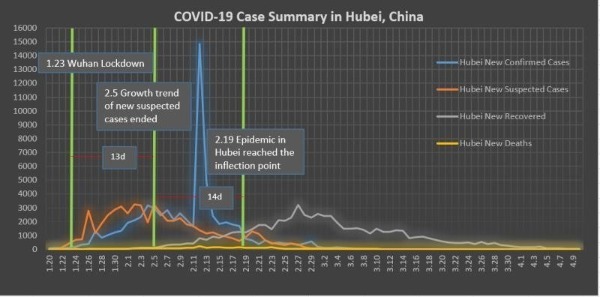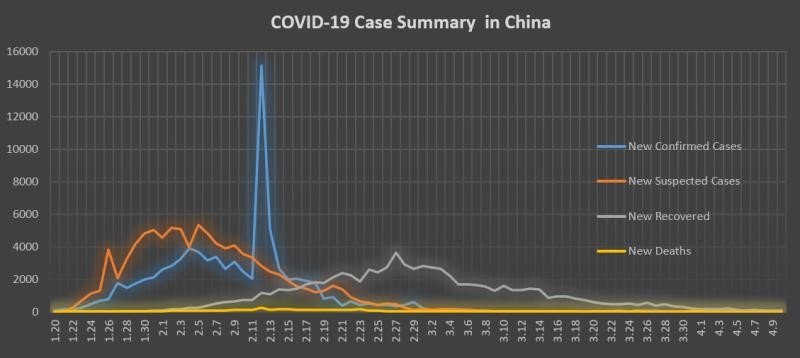How long did it take for the effects of China’s strict prevention and control measures to emerge?
It is important to note that the information provided in this Series is intended for your general knowledge only and is not a substitute for professional medical advice or treatment.
Since the outbreak of COVID-19, China has been adopting the most comprehensive, strictest and most thorough prevention and control strategy. These strategies, seemingly "draconian" to some countries or scholars, have proven to be effective and achieved significant results in a short time, buying valuable time for the global fight against the epidemic.
Thirteen days after the lockdown of Wuhan and the surrounding areas, the number of new suspected cases in Hubei province began to decline. Within two months after the lockdown, Hubei reached the milestone of zero new confirmed cases. Following the outbreak of COVID-19 in Wuhan, the Chinese government decided to impose a lockdown on Wuhan on January 23 to prevent the spread of the disease. In the first ten days of the lockdown, the number of new suspected cases in Hubei province rapidly increased, but this trend had been curbed since February 5. Under the lockdown, Hubei and Wuhan took several key measures to control the outbreak following the requirements of the central guidance team. First, "four categories of personnel" were managed in a differentiated and concentrated manner. Second, 20 national medical teams were urgently mobilized to support Hubei. Third, makeshift hospitals were built to treat patients with mild symptoms. In addition, local governments requisitioned places for centralized quarantine, increased medical equipment and medical personnel, isolated suspected cases and placed close contacts under medical observation.
On February 12, with support from experts of the national medical teams, Hubei concentrated efforts in screening out the existing suspected cases. Starting from February 13, the number of new confirmed cases in Hubei continued to decline. From February 19, the number of new recovered cases in Hubei exceeded that of new confirmed cases. On March 11, the number of new confirmed cases in Hubei fell to single digit for the first time. On March 19, less than two months after the lockdown, no new confirmed cases were reported in Hubei for the first time.

At the national level, the epidemic reached an inflection point 20 days after a full activation of first-level Public Health Emergency Response. After implementing measures of lockdown and centralized treatment in Wuhan, China has contained the spread of the epidemic to other provinces and cities. On January 29, all of the 31 provinces in Chinese mainland launched a first-level Public Health Emergency Response, and all provinces and cities began to fully implement strict control measures. On February 18, for the first time, the number of new recovered cases in China exceeded that of new confirmed cases. On the same day, the number of existing confirmed cases in China reached its highest point, an inflection point in the epidemic control.

China largely contained the epidemic 50 days after locking down Wuhan and the surrounding areas and activating nationwide first-level Public Health Emergency Response, leading to a reduction of 96 percent of infected cases outside Wuhan in China. A study published in Science on March 31 shows that the Wuhan travel ban alone would decrease the number of confirmed COVID-19 cases outside Wuhan to 202,000 (±10,000) and that the national emergency response alone would decrease the number to 199,000 (±8500). As such, either single intervention would not have been able to reverse the trend by February 19. It is the combination of both control measures that prevented further spread of the disease and reversed the incidence rate. The study concludes that these measures reduced 96 percent of confirmed cases outside Wuhan in China.
On the basis of scientific assessment of the risk of the epidemic, China began to resume work and production in batches since February 23. On April 8, Wuhan lifted its lockdown. The gradual exit of strict control measures will help recover social and economic activities and prevent another major outbreak of the epidemic.
References:
[1] 澎湃新闻:《科学》披露武汉封城紧急响应效果:中国新冠感染少了96%,https://baijiahao.baidu.com/s?id=1662755663897976961&wfr=spider&for=pc
[2] 澎湃新闻:英学者《柳叶刀》发文:武汉"封城"为医疗救治争取了喘息期,https://www.thepaper.cn/newsDetail_forward_6745212
[3] 央视新闻:中央赴湖北指导组:应收尽收 刻不容缓,https://baijiahao.baidu.com/s?id=1657967352711134528&wfr=spider&for=pc
Authors: Xu Puheyan, Dong Dandan,Center for International Knowledge on Development
Please feel free to contact us by sending your questions to question@chinadaily.com.cn or commenting on China Daily app. We will ask experts to answer them.














